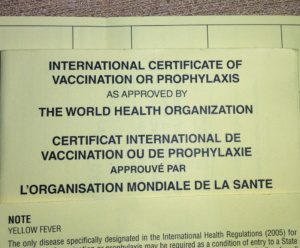By: MJ + PJ
A trip of this undertaking requires scrutiny of your health status and your history of immunizations. It is really not a time to roll a dice with disease. Some conditions are rare but likely fatal, while some are common and debilitating. It is also not as simple as a single visit to your doctor. We started about nine months out on a timeline that was recommended by our doctor and a few travel websites, and it still came down to us collecting a prescription on our Uber ride to our initial international flight. (Hence the delayed publish date of this post!)
In a usual travel scenario you would determine an agenda of specific areas and places, and see what minimum immunizations you needed. Our adventure is more open ended, so we had to guess and prepare for the unlikely types of places we might encounter. Two examples being: we were prepared to camp in remote areas where we may be exposed to wildlife, and we were prepared to volunteer in healthcare or teaching roles if the situation arose. This is why we had a few hurdles and delays.
A good place to start is to have titers drawn to check your immunity status for things you have already been immunized against. Vaccine effectiveness can fade. Dig up your immunizations record. The biology and disease exposures of an individual is unique, and your immunity may have faded in sufficient reactivity since a childhood immunization. Doing this gives you a baseline from which to move forward and/or play catch-up.
If you have a child, this is probably the least fun preparation aspect of the travel they are about to participate in. It also means consultation with a different doctor and appreciating the differences that pediatric medicine has from adult medicine. Some pharmacies have age limits on flu shots, not because the mode or dose is not suitable, but because, in the words of one pharmacist, “We don’t have two or three nurses handy”. Our child took the shots best when sitting on a lap with our hand over his eyes and head turned away. As with many aspects of life – the anticipation anxiety is worse than the actual event.
Private health insurance is not likely to cover “exotic” immunizations… those being the ones that do not involve you surviving childhood or usual disease risks in your region (e.g. DPT, MMR, polio etc). Read around to see what your national or private health coverage does and does not include.
In the US you can visit your doctor, or a state or CDC travel clinic to get advice, some immunizations, and an accessible formal immunization record. It is a good idea to carry an up to date record with you and to have some sort of electronic copy handy for reference should you need it. Another consideration is that as well as a visa for entering specific countries you may also need proof of immunization. A good example of this is proof of yellow fever vaccination for entry into countries. Also keep in mind that some conditions now have vaccines available – conditions that are both new or old – the Zika virus and Ebola virus are examples.
A private travel health company called Passport Health in the US has a network of clinics that makes it simpler (a relative term) to be on the move while tidying up the less usual international immunizations. It is a good idea to scour the resources in your home country prior to departure, and consult with your physician.
So what are the immunizations you are likely to need for a year-long worldwide trip where the risk is higher than usual for crossing paths with serious diseases? Try this list for size:
– Rabies (no immunity, but buys you two days to get to the booster treatment)
– Yellow Fever (some countries require proof of vaccination for entry)
– Japanese Encephalitis (region specific)
– Malaria (not tidily distributed in regions)
– Cholera (has no pediatric vaccine)
– Typhoid (pills!)
– Hepatitis (A and B)
For this list in the US, you are looking at about $10,000 for three people, so plug that into your budget. The good thing for many of these being that they are rare costs or a once only cost for your lifetime.
The best reference source for incidence and exposure to worldwide disease risks is your federal health authority. You can also read the health advice offered by the actual countries you are visiting. The World Health Organization (WHO) has fact sheets and travel recommendations also.

